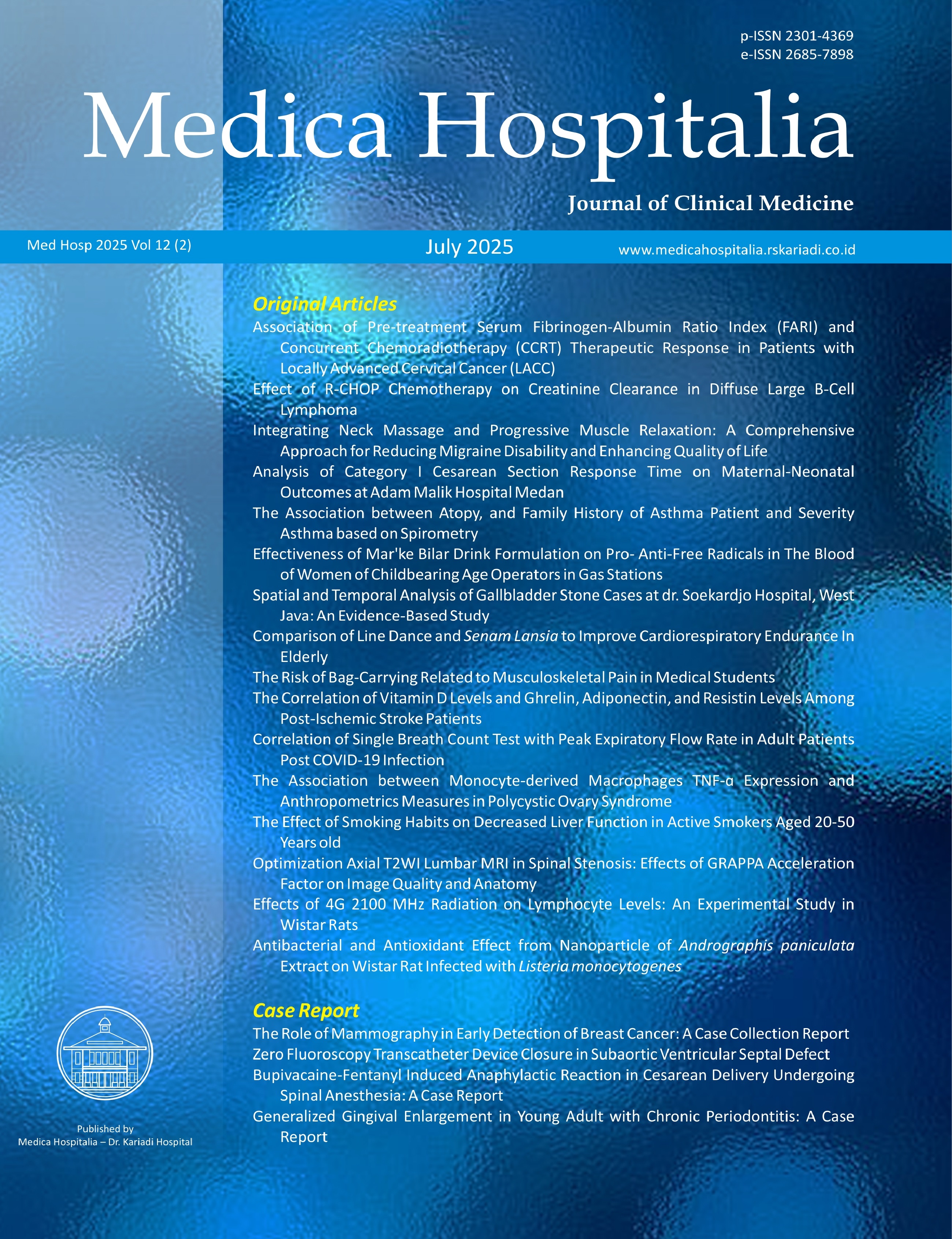Zero Fluoroscopy Transcatheter Device Closure in Subaortic Ventricular Septal Defect
DOI:
https://doi.org/10.36408/mhjcm.v12i2.1289Keywords:
ventricular septal defect closure, zero fluoroscopy, echocardiography-guidedAbstract
Background: For the last decade, transcatheter closure of ventricular septal defect (VSD) has been the treatment of choice, using fluoroscopy as a guide. However, the risk of radiation and/or contrast agent exposure has been an issue, especially in young patients. We would like to highlight the first case of zero fluoroscopy transcatheter VSD closure in Central Java.
Case Illustration: A 27-year-old female was referred to outpatient department due to worsening shortness of breath in the last 3 months before admission. She had a history of recurrent respiratory tract infections, feeding difficulty, and failure to thrive. Her vital signs were stable, 99% oxygen saturation, and grade 3/6 pansystolic murmur in the lower left sternal border. Transoesophageal echocardiography showed 3 mm subaortic VSD, left to right shunt. Transcatheter VSD closure was successfully done using Konar-MF™ VSD Occluder No. 8/6 mm retrograde approach without fluoroscopy.
Conclusion: The first zero fluoroscopy transcatheter device closure in Central Java has been successfully done in a 27-year-old female with subaortic VSD. Zero fluoroscopy transcatheter VSD closure is a feasible, safe, and effective procedure.
Downloads
References
1. Minette MS, Sahn DJ. Ventricular septal defects. Circulation 2006; 114: 2190–2197.
2. Prakoso R, Ariani R, Lilyasari O, Kurniawati Y, Siagian SN, Sakidjan I, et al. Percutaneous atrial septal defect closure using transesophageal echocardiography without fluoroscopy in a pregnant woman: A case report. Med J Indones 2020; 29: 228–232.
3. Siagian SN, Prakoso R, Mendel B, Hazami Z, Putri VYS, Zulfahmi, et al. Transesophageal echocardiography-guided percutaneous closure of multiple muscular ventricular septal defects with pulmonary hypertension using single device: A case report. Front Cardiovasc Med 2023; 10: 1–5.
4. Hill NE, Giampetro DM. Fluoroscopy Contrast Materials, http://www.ncbi.nlm.nih.gov/pubmed/33240462 (2024).
5. Andreucci M, Solomon R, Tasanarong A. Side effects of radiographic contrast media: pathogenesis, risk factors, and prevention. Biomed Res Int 2014; 2014: 741018.
6. Baumgartner H, de Backer J, Babu-Narayan S V., Budts W, Chessa M, Diller GP, et al. 2020 ESC Guidelines for the management of adult congenital heart disease. Eur Heart J 2021; 42: 563–645.
7. Kanaan M, Ewert P, Berger F, Assa S, Schubert S. Follow-up of patients with interventional closure of ventricular septal defects with Amplatzer Duct Occluder II. Pediatr Cardiol 2015; 36: 379–85.
8. Singab H, Elshahat MK, Taha AS, Ali YA, El-Emam AM, Gamal MA. Transcatheter versus surgical closure of ventricular septal defect: a comparative study. Cardiothorac Surg 2023; 31: 8.
9. Chen GL, Li HT, Li HR, Zhang ZW. Transcatheter closure of ventricular septal defect in patients with aortic valve prolapse and mild aortic regurgitation: Feasibility and preliminary outcome. Asian Pac J Trop Med 2015; 8: 315–318.
10. Zhang W, Wang C, Liu S, Zhou L, Li J, Shi J, et al. Safety and Efficacy of Transcatheter Occlusion of Perimembranous Ventricular Septal Defect with Aortic Valve Prolapse: A Six-Year Follow-Up Study. J Interv Cardiol 2021; 2021: 6634667.
11. Tim Penyusun PPK. Penutupan defek septum ventrikel dengan device tanpa fluoroskopi. In: Panduan Praktik Klinis PJN Harapan Kita. Jakarta: Lembaga PJN Harapan Kita, 2023, pp. 541–5.
12. PERKI. Panduan Tatalaksana Penyakit Jantung Bawaan pada Pediatrik. 2nd ed. Jakarta, https://inaheart.org/wp-content/uploads/2021/07/Pedoman_Tatalaksana_Gagal_Jantung_2020.pdf (2024).
13. Thakkar B, Patel N, Bohora S, Bhalodiya D, Singh T, Madan T, et al. Transcatheter device closure of perimembranous ventricular septal defect in children treated with prophylactic oral steroids: acute and mid-term results of a single-centre, prospective, observational study. Cardiol Young 2016; 26: 669–76.
14. Carminati M, Butera G, Chessa M, De Giovanni J, Fisher G, Gewillig M, et al. Transcatheter closure of congenital ventricular septal defects: results of the European Registry. Eur Heart J 2007; 28: 2361–8.
15. Holzer R, de Giovanni J, Walsh KP, Tometzki A, Goh T, Hakim F, et al. Transcatheter closure of perimembranous ventricular septal defects using the amplatzer membranous VSD occluder: immediate and midterm results of an international registry. Catheter Cardiovasc Interv 2006; 68: 620–8.
16. Predescu D, Chaturvedi RR, Friedberg MK, Benson LN, Ozawa A, Lee K-J. Complete heart block associated with device closure of perimembranous ventricular septal defects. J Thorac Cardiovasc Surg 2008; 136: 1223–8.
Additional Files
Published
How to Cite
Issue
Section
Citation Check
License
Copyright (c) 2025 Marco Wirawan Hadi, Tahari Bargas Prakoso, Rille Puspitoadhi Harjoko, Sefri Noventi Sofia (Author)

This work is licensed under a Creative Commons Attribution-ShareAlike 4.0 International License.
Copyrights Notice
Copyrights:
Researchers publishing manuscrips at Medica Hospitalis: Journal of Clinical Medicine agree with regulations as follow:
Copyrights of each article belong to researchers, and it is likewise the patent rights
Researchers admit that Medica Hospitalia: Journal of Clinical Medicine has the right of first publication
Researchers may submit manuscripts separately, manage non exclusive distribution of published manuscripts into other versions (such as: being sent to researchers’ institutional repository, publication in the books, etc), admitting that manuscripts have been firstly published at Medica Hospitalia: Journal of Clinical Medicine
License:
Medica Hospitalia: Journal of Clinical Medicine is disseminated based on provisions of Creative Common Attribution-Share Alike 4.0 Internasional It allows individuals to duplicate and disseminate manuscripts in any formats, to alter, compose and make derivatives of manuscripts for any purpose. You are not allowed to use manuscripts for commercial purposes. You should properly acknowledge, reference links, and state that alterations have been made. You can do so in proper ways, but it does not hint that the licensors support you or your usage.
























